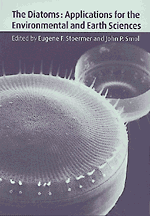Book contents
- Frontmatter
- Contents
- Contributors
- Preface
- Part I Introduction
- Part II Diatoms as indicators of environmental change in flowing waters and lakes
- 2 Assessing environmental conditions in rivers and streams with diatoms
- 3 Diatoms as indicators of hydrologic and climatic change in saline lakes
- 4 Diatoms as mediators of biogeochemical silica depletion in the Laurentian Great Lakes
- 5 Diatoms as indicators of surface water acidity
- 6 Diatoms as indicators of lake eutrophication
- 7 Continental diatoms as indicators of long-term environmental change
- 8 Diatoms as indicators of water level change in freshwater lakes
- Part III Diatoms as indicators in extreme environments
- Part IV Diatoms as indicators in marine and estuarine environments
- Part V Other applications
- Part VI Conclusions
- Glossary, and acronyms
- Index
3 - Diatoms as indicators of hydrologic and climatic change in saline lakes
Published online by Cambridge University Press: 16 January 2010
- Frontmatter
- Contents
- Contributors
- Preface
- Part I Introduction
- Part II Diatoms as indicators of environmental change in flowing waters and lakes
- 2 Assessing environmental conditions in rivers and streams with diatoms
- 3 Diatoms as indicators of hydrologic and climatic change in saline lakes
- 4 Diatoms as mediators of biogeochemical silica depletion in the Laurentian Great Lakes
- 5 Diatoms as indicators of surface water acidity
- 6 Diatoms as indicators of lake eutrophication
- 7 Continental diatoms as indicators of long-term environmental change
- 8 Diatoms as indicators of water level change in freshwater lakes
- Part III Diatoms as indicators in extreme environments
- Part IV Diatoms as indicators in marine and estuarine environments
- Part V Other applications
- Part VI Conclusions
- Glossary, and acronyms
- Index
Summary
Introduction
Lakes are intricately tied to the climate system in that their water level and chemistry are a manifestation of the balance between inputs (precipitation, stream inflow, surface runoff, groundwater inflow) and outputs (evaporation, stream outflow, groundwater recharge) (Mason et al., 1994). Hence, changes in the hydrologic budget, caused by either climatic change or human activity, have the potential to alter lake level and lake chemistry. These, in turn, may affect the physiological responses and species composition of the lake's biota, including those of diatoms. Here, we review the use of diatoms as indicators of hydrologic and climatic change, with an emphasis on environmental reconstruction in arid and semi-arid regions. First we discuss linkages among climate, hydrology, lake hydrochemistry, and diatoms that form the foundation for environmental reconstruction and then review selected examples of diatom-based studies.
LAKE HYDROLOGY AND HYDROCHEMISTRY
Lakes vary in their hydrologic sensitivity to climatic change (Winter, 1990). In basins with a surface outlet, lake-level increase is constrained by topography, and any change in input is usually balanced by outflow. Thus, in open basins, lake level fluctuates relatively little, unless hydrologic change is sufficiently large to drop water level below the outlet level. In contrast, closed-basin lakes, that is lakes without surface outflow, often show changes in level associated with changes in the balance between precipitation and evaporation (P – E). The magnitude of response to fluctuations in P – E depends on the relative contribution of groundwater inflow and outflow to the hydrologic budget; lake-level change is greatest in terminal basins, which have neither surface nor groundwater outflow.
- Type
- Chapter
- Information
- The DiatomsApplications for the Environmental and Earth Sciences, pp. 41 - 72Publisher: Cambridge University PressPrint publication year: 1999
- 59
- Cited by



